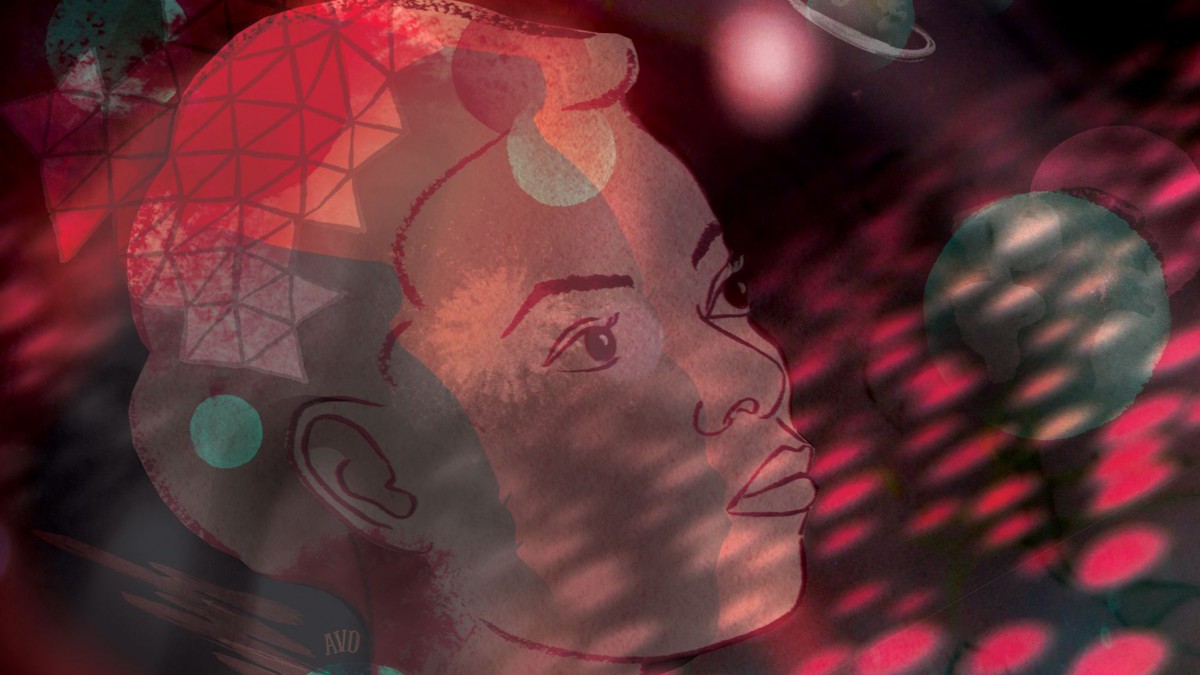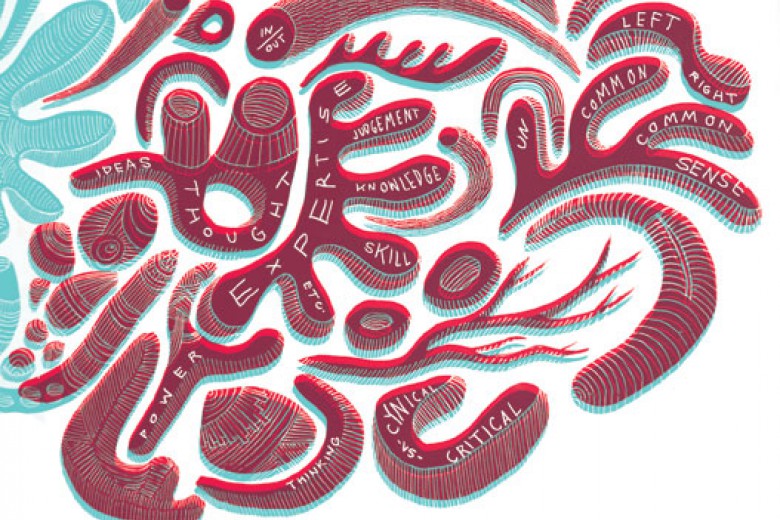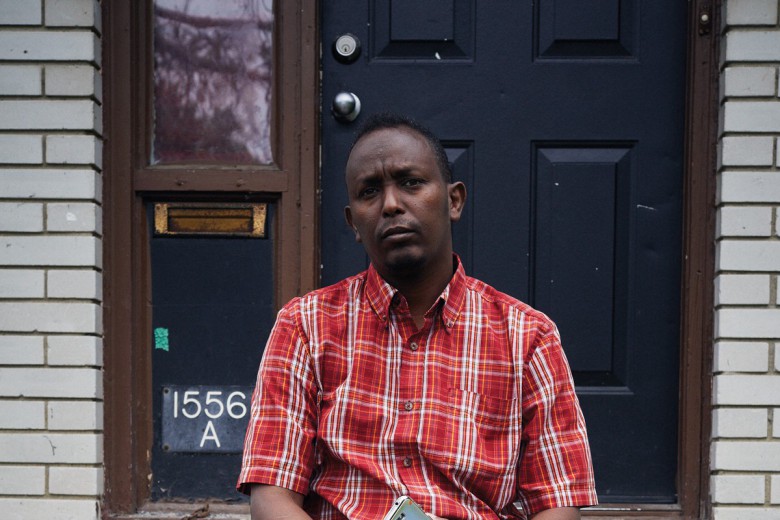When we emblazon a banner with the slogan “another world is possible,” how much have we imagined about what that other world is? Movement work involves envisioning and building worlds with new relationships of power and intersections of identity and collective change. We can get to this new world if we spend some creative time there – through writing and reading – and envisioning how it looks, feels, and functions.
Visionary fiction, a term coined by writer, poet, and organizer Walidah Imarisha, is a genre that spans science fiction, fantasy, speculative fiction, and comics. It uses the lens of science fiction to explore world building by addressing current social issues in ways that are conscious of power inequalities, intersecting identities, and collective change. The genre, like social justice work, is not neutral, nor is it reformist: it’s political, realistic, and challenging, but also hopeful. It relies not on what we have, but on visualizing what we want.
The stalwarts of visionary fiction – Ursula K. Le Guin, Octavia E. Butler, Marge Piercy, Starhawk, Samuel R. Delany, W.E.B. Du Bois – imagine away oppression, develop radically transformed systems of governance, and explore new paradigms of sexuality, relationships, and gender. Le Guin’s novel The Dispossessed, for instance, explores what happens in a post-revolutionary world when those oppressive constructs we sought to dismantle begin to re-emerge in a new society. Le Guin teases out the challenges of existing in a world that is not as perfect as the revolution had hoped, and is more susceptible to replicating oppressive structures than most people had thought. While Le Guin gives us a vision of what an anarchist society could truly look like, she also gives us a tale about how revolution is not a fixed point but something that needs to remain in motion, with critical reflection as a part of the process.
JUMP INTO VISIONARY FICTION WITH RECOMMENDED READINGSThe Fifth Season, by N.K. Jemisin
The Long Way to a Small, Angry Planet, by Becky Chambers
Octavia’s Brood: Science Fiction Stories from Social Justice Movements, edited by Walidah Imarisha and adrienne maree brown
Parable of the Talents, by Octavia E. Butler
Emergent Strategy, by adrienne maree brown
The Fifth Sacred Thing, by Starhawk
The Dispossessed, by Ursula K. Le Guin
Santa Olivia, by Jacqueline Carey
Woman on the Edge of Time, by Marge Piercy
Who Fears Death, by Nnedi Okorafor
What is a world without prisons, police brutality, sexual violence, poverty, oppression? We don’t know. But we work for one, building as we go. Visionary fiction lets us explore and construct answers to these questions in worlds free of the constraints that bind our work in our current real world. We can test ideas, trying out new paradigms of relationships and constructs of social order that not only push forward ideas of new societies, but also challenge our own emotions and assumptions.
In these imagined worlds, we get to release the hopes and desires we carry with us in our organizing work. Taking the time to explore the future through imagined worlds flexes our imaginations and offers a balance to the day-to-day practical work of organizing for social change.
Visionary Fiction in Practice
The U.S.-based LGBTQ prisoner support organization Black and Pink recently embarked on a collective visionary fiction-writing project with its incarcerated members and free-world allies, including members who were formerly incarcerated and their supporters. Through its monthly newsletter, which is sent to 8,200 prisoners, Black and Pink is writing a world without prisons by collecting and publishing the stories of its incarcerated members. This abolition work envisions collective change for millions of incarcerated people, mostly people of colour.
Here’s how it works: the project imagines a trio of solar systems that represent different places in the resistance to mass incarceration. One planet is deeply steeped in incarceration: it is cruel and merciless. Another planet is trying to undo mass incarceration, exploring the restoration and the conflicts between reform and abolition. The third planet is one that has never known incarceration; it is a place to explore what is possible without punishment ever having been a part of a species’ consciousness. Common to all these worlds are birds that can deliver messages, even across space – a nod to the role that those on the outside play in connecting and supporting leadership among the incarcerated.
Any member can contribute a story, a character, a conflict, or a complication about any one of those solar systems, as long as the contributions are consistent with the relationships of the planets to incarceration. Black and Pink chooses three contributions (one per solar system) to print in the following newsletter, and then invites inmates to build on the evolving story, collectively forming a narrative that imagines three kinds of worlds that relate to the prison industrial complex.
Who better to imagine away the carceral state and form a new vision of the world we’re working toward than those who are incarcerated? Though the power of the prison system to crush hope is immense, the power of the imagination is also tremendous, empowering people – even in a prison cell – to create a vision of another way of life. A prisoner might slip into the life of a mutant, say, that affirms their identity. This mutant might fight and win the right to be a part of the larger world, which is seen as a gift, not a danger. The full vision of the story will be a powerfully creative image of how prison abolition looks, feels, and functions.
Troubled imaginaries
Many of our favourite imagined worlds in science fiction, far from being visionary, are full of problematic tropes that replicate the oppressive social and political problems we struggle with in our work for change. This is hardly surprising; after all, the publishing, film, and television industries are all products of the capitalism that defaults to a heteronormative, white, cis-male-dominated world around which all stories revolve. It is predictable, then, that most of what is produced merely replicates the oppressive structures and thought patterns of the dominant paradigm, even when presenting political allegory. Star Trek takes place in a post-capitalist era in which the fundamental ills of poverty and prejudice are banished. But what remains is still military might, occupation, colonization, and coercion. In J.K. Rowling’s Harry Potter series, Harry ends up as an Auror – essentially a cop – and all of the primary characters are in heteronormative relationships. In Game of Thrones (both the books and the television series), sexual violence is a common weapon, and despite the presence of some powerful women, patriarchy reigns. The storytelling in Firefly is rife with orientalism, though Asian actors aren’t featured in the main cast. These flaws are indicative. Just as there is instruction in visionary fiction, there’s instruction in flawed imaginative fiction. As thoughtful readers and watchers, we begin to construct challenges to the problems we perceive within their rules. This is valuable practice for our work. It’s in these flaws that analyses can be built and tactics practised. If we can imagine a better United Federation of Planets (or imagine it away, with something new in its place), we can practise what it means to imagine away state violence and the militarization of scientific exploration while holding on to the things we love.
Ideas into practice
How can visionary fiction begin to guide practice? After years of facilitating direct action trainings, I started to feel they lacked context. Either the people in the trainings weren’t engaged in campaigns that involved current direct action, or they had no immediate outlets where they could practise their new knowledge. Newly learned skills that go unused often get lost. But what if the context could be imagined?
At the Boston-area Education for Social Justice conference two years ago, I led a group of mostly Black and Latinx young people in a training session about visionary fiction and direct action. As part of the process, participants broke into small groups, each choosing an imagined world within which to work. One group took the world of Harry Potter. Rather than identifying with the title character or one of his best friends, the group identified with Squibs, non-magical people born into magical families. Squibs miss out on all the special memories, rituals, and shared cultural associations that the other children in a magical family get to experience, including the remarkable chance to attend wizarding school. The young people in the training could relate – they too had felt the sting of exclusion and othering. Impacted by histories of family trauma, migration, community violence, incarceration, and poverty, they were ill-equipped for a standard classroom setting, falling far outside the expected normal high-school student experience.
During the workshop, using direct-action training tools developed out of the U.S. civil rights movement and U.S.-based organizations like the Ruckus Society and Beautiful Trouble, these students built campaigns for Squib rights. They were building context, and it took no time at all for them to draw parallels between their imagined Squib rights campaign and changes they wanted to see at their school that could transform the default environment of isolation and suspension without regard for context. Just as there seemed to be no regard for how a Squib would feel about being in a magical world without the resource of magic, the students felt there was no regard for the context of their lives from school administrators and teachers. By the end, the imagined had given way to the real as they discussed forming a student group to move their ideas forward.
Direct action contains the elements of good storytelling: heroes and heroines, conflict, allies, landscapes and, of course, villains who jeopardize our future. In direct action organizing, we use phrases like “the spectrum of allies,” “the action target,” and “point of intervention.” But an affinity group could be called a “fellowship” and a campaign a “quest.”
To reap the benefits of using visionary fiction as an organizing tool in our work, we have only to open ourselves up to the partnership of the imagined and the real. The lessons we can learn by doing so are important. How can imagined, familiar worlds inspire us in our work? Our new, possible world lies in the futures we can imagine.
The following is a visionary fiction excerpt by Morrigan Phillips from Octavia’s Brood: Science Fiction Stories from Social Justice Movements.
Cy shifted on the cot, covered her eyes with an arm. A sharp rap on her cell door startled Cy just moments later. A harsh voice shouted, “Prisoner, clear away from the door!” A guard entered, followed by three others dressed clearly in uniforms of the Provincial Army. Moving quickly toward Cy they lifted her up and before the familiar burlap sack came down around her head Cy saw the crest of House Holt embroidered the overcoats of the soldiers. Cy’s heart pounded. Something about that crest felt foreboding.
Out of the cell, the guards went left instead of the usual right to the courtyard. After ascending several flights of stairs, her guards pushed Cy roughly into a room, forced her to sit. A moment later, light flooded her vision. The room came into focus in bits and pieces. Walls made of large stone like the rest of the prison, but the floor of this room was a deep polished amber wood. She sat on a small wooden stool at a large table. Across from her sat another person – Councilman Holt himself.
“Do you know how long you have been here in this castle, Cy?”
“This prison, you mean?” Cy met Holt’s eyes.
Holt pursed his lips. “Four months.”
Cy spoke again, fear making her mouth dry. “After all these months, I cannot imagine what there could be between us that needs discussing.”
“What is between us?” Holt gave a snort. “Your existence! That is what remains between us. Your existence and that of the other Memorials held here.”
“‘Held here?’” Anything to avoid the word imprisoned, thought Cy.
“The war in the North moves apace,” he continued. “The people are aligned with this progress but so long as you and the others are here…”
Holt stood and moved toward an open window. “Well, then there is always the threat of the question ‘_Why?_’”
“You fear the people remembering.” Cy tried to make Holt look at her, but his eyes would not leave the view. “That they will remember you took me and the others away. That you killed many and burned the libraries and they will ask ‘Why.’ And you will have to answer.”
“Oh shut up!” Holt snapped irritably, finally stepping away from the window. “Only the nostalgic will truly question your absence and care. The Long Memory fades and soon enough memories will be what they should, myth and legends.” Cy thought Holt sounded weary or perhaps frustrated.
“You cannot render memory powerless, Holt,” Cy said. “You could round up each and every Memorial in the Archipelago and let us rot in these cells. You could ensure that each newly born Memorial never has their skill fostered. In that you could most definitely end our line. But you will not eradicate memory.”
Even as she said it, though, Cy wondered about the Isle of All and doubted.
The binding, Makati’s story, her own memories – it all meant something.
Whispering to herself, Cy mused, “A people who remember will not be exploited again. A people who remember will take action.”
A horrible realization began to take form in Cy’s mind. People were not remembering. They could not remember, not those things of the past that shape the present.
“Memories are supposed to be shared, it is what gives them power.” She said this loudly, though it was directed as much to herself as to Holt. “Perhaps it is time the people remember for themselves.”
Cy looked directly at Holt.
Holt peered at Cy, leaning closer. “What?” He forced the question through gritted teeth.
“Do your worst, Holt. But without the Memorials, memories will have to go somewhere. Each person holds their own memory of what they have lived through and seen. You can not take that or destroy that, for it is human.”
Holt’s face turned nearly purple with rage. In just a few strides, Holt had rounded the table and drawn a short sword from his belt. He pulled Cy’s head back, exposing her neck. Cy’s heart beat erratically and her face flushed. Her eyes travelled down to the blade and its hilt, on which the crest of House Holt was inlaid in gold. In an instant Cy wasn’t in the room with Holt. She was far away in a another moment of her past life, lying on hard-packed dirt, screaming as a man pulled her away from the prone dead body of her father. There was a flash of swords, one very nearly cutting Cy in the stomach. The sword had the same crest.
Just as suddenly, Cy was back in the room with Holt. Her eyes moved from the sword to the crest on Holt’s vest, to the many crests of House Holt on the banners and tapestries of the room. Cy’s chest heaved. She felt bile rising in her throat and thought she would be sick. Why had she not been able to put it together before now? It was Holt’s armies that had killed her family. Her whole village. Cy closed her eyes tightly. The memory of the council hearing, the one she had always struggled to see through. She always lost it as Holt rose to speak under his house crest.
“It was you,” she gasped. “You killed…your armies killed my people. It was House Holt.” Cy’s chest heaved and she leaned forward, pulling on her restraints.
“Oh ho! She remembers. She remembers what truly remains between us.” Holt was smiling.
Cy began to struggle hard against her shackles. She wanted to leap at Holt. To hurt and maim him. Cy could only see that crest and it filled her with a panic and rage like she had never known. Cy screamed, “I don’t need the long memory to know what you and your wealth have done to my people. I lived it! Others will remember too.” Holt clapped his hand over her mouth, face just inches from Cy’s.
“Your people are weak,” he spat. “They remember nothing of who they once were. Only that they are now lawless barbarians.”
Holt struck Cy across the cheek with the hilt of his sword, knocking her to the floor. Stepping over her, he gestured to the soldiers.
“Remove her.” He stood with his back to Cy as she was hoisted up, dazed from the blow. “As a Memorial, Cy, you should know it is easier to control what people do with their memories than one might think.”







